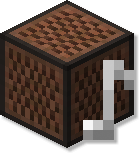Although I use LMMS to make music nowadays, it wasn’t always like that. From a young age, I was fascinated by the storytelling of music. Hearing how the emotion evolved and grew. But listening to music wasn’t all I had in mind: I wanted to make it!
I had originally started in a little program called Anvil Studio. I don’t remember Anvil Studio ever having an official piano roll to input notes into. I had to intentionally place each note and rest into the staff. I only ever made two tracks in it, and they were terrible!
As I grew up just a little, I remember watching Minecraft videos that played famous songs on “note blocks”. Note blocks were special, place-able boxes that produced different sounds depending on the surface it was on. After struggling to place blocks for hours, I learned about a program called Note Block Studio.
Note Block Studio fascinated me because it could generate a world identical to those that I saw in YouTube videos. From there I started transcribing any piece of music I could get my hands on into a Minecraft version. After a while, I remembered the tracks I made in Anvil Studio and tried to make those work too. The biggest problem with Note Block Studio is that the game restricted you to a specific range of notes, meaning that any note too high or low wouldn’t be played.
Because of this limitation, I tried to create music within the constraints of the Minecraft world. These pieces were never very good and I hated having my creative freedom limited to such a small range. Note Block Studio also allowed you to play notes outside the range of Minecraft’s capability, but wouldn’t be able to play them in the game.
After a while, I wanted to really get into making my own music. Still being a kid, I couldn’t afford the biggest, coolest DAWs on the market. That led me to finding LMMS.

LMMS was the most powerful DAW that I had ever used before. It could make loop tracks, it had a piano roll that was easy to use, and it had tons of instruments and samples to choose from! While it still has its own limitations, it gave me the freedom that I craved.
I started right away with just the samples that were built right in. In hindsight, I still had no clue what I was doing, but I was having a blast! In a few days, I had finished four different projects.
After those short videogame loop tracks, I wanted to explore all genres of music. Quickly, I researched into the different instruments needed for each piece. The first new instrument that I got was an orchestral soundfont. Soundfonts are a lot like sample packs, but are entirely self contained.
Soundfonts kept me occupied for over a year. In time, my musical ear developed to the point where each composition would annoy me. The soundfonts, though my loyal companion, did not have enough dynamic range to them. This is when I started using Virtual Studio Technology (VST) instruments.
VST instruments were even more powerful than simple sample libraries and soundfonts. VSTs natively had different articulations and sounds for each instrument. Some of my favorites can even add instrument noises that make your music sound natural. At last, I had the instruments to make my music sound even better!
What I have learned over the years is to never throw an idea away. In 3 years, I have never deleted a project. I cannot tell you how many times I have combed through the list of “Sound Bites” to find a melody, chord progression, or inspiration for a composition I was working on.
And that is my story so far. If you like this article, consider checking out these 12 FREE VST Instruments or why I think LMMS is underrated.




